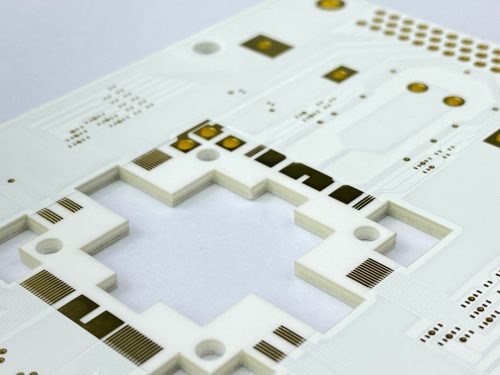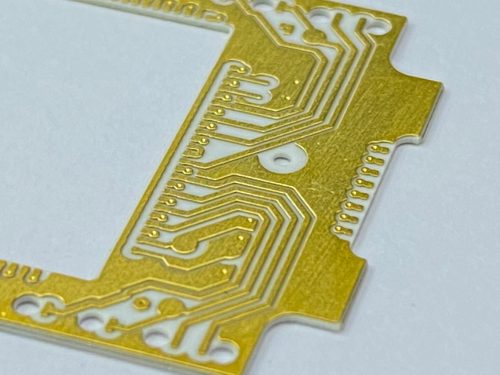CERAMIC PCBS
— THERMAL MANAGEMENT OPTIMISATION —
ABOUT CERAMIC PCBs
With recent advances in the market, Ceramic PCBs have become a more viable option for PCB designers. With the continuing requirements for miniaturisation, microelectronics and high-power LED packages, the need for substrates capable of withstanding high operating temperatures, whilst offering outstanding thermal performance is a must.
Ceramics have been widely used in electronics/electronic components for years due to their thermal, and mechanical advantages. With recent advances in technology and manufacturing capabilities, they are now replacing entire PCBs.
Since their introduction, Ceramic PCBs have received enormous attention from the industry as an effective solution to a range of electronic issues. The superior Thermal Conductivity of ceramics being the leading reason that more and more industries are turning to ceramics for their PCB design.
ADVANTAGES OVER OTHER TECHNOLOGIES
Heat dissipation is the key advantage that Ceramic has over more conventional materials such as FR4 and Metal Clad PCBs. With components being placed directly on the boards, and no isolation layer, the flow of heat through the boards is far more efficient.
In addition to this, Ceramic material can withstand high operating temperatures (up to 350°C) and has a very low CTE (Coefficient of Thermal Expansion), allowing for additional compatibility options for circuit design.
See a full list of advantages below:
- Superior values of Thermal Conductivity (up to 170W/mK)
- Higher operating temperatures up to 350°C
- Lower CTE
- Suitable for high frequency applications due to low signal loss
- Possibility for Hermetic packages with 0% water absorption

DK THERMAL CAPABILITIES
DK Thermal specialises in Alumina Oxide (Al2O3) and Aluminium Nitride (AIN) boards. Direct bond copper (DBC) and direct plated copper (DPC) technologies are used for the circuitry depending on the requirements and/or applications.
Depending on the technology required or the end application, circuits can be printed using either Copper (Cu) or Silver (Ag).
If using a Copper (Cu) track, solder resist/ident/surface finish options are much the same as conventional PCBs. If Silver (Ag) is being used we use a clear/glass solder mask. Gold plating can also be used in certain applications where the silver pads require protection.
See below for more information on Al2O3, AIN, and other technologies available.
ALUMINA OXIDE (Al2o3) PCB (96% & 99.6%)
ABOUT
The most common material used for Ceramic PCBs is Alumina Oxide (96%). A naturally excellent electrical insulator with strong thermal properties. The thermal conductivity of Alumina is not as high as Aluminium Nitride, however it is still noticeably higher than the best performing Metal Clad PCB materials with a Thermal Conductivity in the region of 24W/mK. Another variant of this is Al203 (99.6%) which has a higher Thermal Conductivity, in the region of 29W/mK.
A high light reflectivity, along with good thermal properties makes Alumina Oxide well suited for LED applications. Whilst low values of thermal expansion and signal loss make it suitable for a range of applications including sensor modules, high-frequency systems and cooling systems.
ADVANTAGES
- High values of Thermal Conductivity (24-29W/mK)
- High operating temperatures up to 350°C
- Low CTE
- Suitable for high frequency applications due to low signal loss
- High light reflectivity
- Possibility for Hermetic packages with 0% water absorption
ALUMINIUM NITRIDE (AlN)
ABOUT
If a higher thermal conductivity is required then Aluminium Nitride (AlN) will be required. AlN has a superior thermal conductivity; depending on options, the conductivity achieved will be between 150-170W/mK.
This, along with a very low CTE and high operating temperatures makes AlN suitable for a variety of applications including; High power LEDs, testing, sensors, Integrated Components (ICs) and more.
ADVANTAGES
- Superior values of Thermal Conductivity (Up to 170W/mK)
- High operating temperatures up to 350C
- Very low CTE
- Suitable for high frequency applications due to low signal loss
- Possibility for Hermetic packages with 0% water absorption


